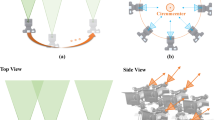Abstract
Recently, interest in internet of things (IoT) has increased, and a lot of technologies are being developed, especially using cameras. However, normal cameras used in the IoT have limited viewing angles and can not acquire a wide range of high resolution images. Image stitching in IoT devices has a problem that requires a large amount of computation. Therefore, we propose a method to distribute the high computational load by transmitting the individual image transmitted from the IoT device with the camera to the cloud and computing the homography information necessary for stitching the image and transmitting the information to the client. In addition, we propose an improved feature point descriptor extraction technique to reduce the amount of stitching computation for real-time processing. Experimental results show that the speed of panoramic image stitching can be improved by dispersing the computational complexity, and smooth panoramic images can be generated.












Similar content being viewed by others
References
Pavithra, D., & Balakrishnan, R. (2015). IoT based monitoring and control system for home automation. In 2015 global conference on communication technologies (GCCT) (pp. 169–173). IEEE.
Gubbi, J., Buyya, R., Marusic, S., & Palaniswami, M. (2013). Internet of Things (IoT): A vision, architectural elements, and future directions. Future Generation Computer Systems, 29(7), 1645–1660.
Sgouropoulos, D., Spyrou, E., Siantikos, G., & Giannakopoulos, T. (2015). Counting and tracking people in a smart room: An IoT approach. In 2015 10th international workshop on semantic and social media adaptation and personalization (SMAP) (pp. 1–5). IEEE.
Chen, C., & Klette, R. (1999). Image stitching-comparisons and new techniques. In International Conference on Computer Analysis of Images and Patterns. Springer, Berlin, Heidelberg (pp. 825–835). Berlin: Springer.
Szeliski, R. (2006). Image alignment and stitching: A tutorial. Foundations and Trends® in Computer Graphics and Vision, 2(1), 1–104.
Burt, P., & Adelson, E. (1983). A multiresolution spline with application to image mosaics. ACM Transactions on Graphics (TOG), 2(4), 217–236.
Tang, C., Dong, Y., & Su, X. (2008). Automatic registration based on improved SIFT for medical microscopic sequence images. In Second international symposium on intelligent information technology application, 2008. IITA’08 (Vol. 1, pp. 580–583). IEEE.
Kim, Y., Han, W., Lee, Y., Kim, C., & Kim, K. (2017). Object tracking and recognition based on reliability assessment of learning in mobile environments. Wireless Personal Communications, 94(2), 267–282.
Ahn, H., & Lee, Y. (2016). Performance analysis of object recognition and tracking for the use of surveillance system. Journal of Ambient Intelligence and Humanized Computing, 5(7), 673–679.
Brown, M., & Lowe, D. (2002). Invariant features from interest point groups. In BMVC 2002: 13th British machine vision conference (Vol. 4, pp. 253–264).
Zitova, B., & Flusser, J. (2003). Image registration methods: A survey. Image and Vision Computing, 21(11), 977–1000.
Brown, M., & Lowe, D. (2007). Automatic panoramic image stitching using invariant features. International Journal of Computer Vision, 74(1), 59–73.
Lowe, D. (2004). Distinctive image features from scale-invariant keypoints. International Journal of Computer Vision, 60(2), 91–110.
Ahn, H., & Rhee, S. (2012). Fast image stitching based on improved surf algorithm using meaningful features. The KIPS Transaction: Part B, 19B(2), 93–98.
Kim, J., & Kim, D. (2014). Matching points filtering applied panorama image processing using SURF and RANSAC algorithm. Journal of the Institute of Electronics and Information Engineers, 51(4), 144–159.
Tron, R., & Vidal, R. (2011). Distributed computer vision algorithms. IEEE Signal Processing Magazine, 28(3), 32–45.
Szeliski, R. (1994). Image mosaicing for tele-reality application. In Applications of computer vision, 1994., Proceedings of the second IEEE workshop on. IEEE (pp. 44–53). IEEE.
Helava, U. V. (1988). Object-space least squares correlation. PE&RS, 54(6), 711–714.
Juan, L., & Gwun, O. (2009). A comparison of sift, pca-sift and surf. International Journal of Image Processing (IJIP), 3(4), 143–152.
Mandle, P., & Bharat, P. (2016). An advanced technique of image matching using SIFT and SURF. International Journal of Advanced Research in Computer and Communication Engineering, 5(5), 462–466.
Othman, M., Khan, A., Shuja, J., & Mustafa, S. (2017). Computation offloading cost estimation in mobile cloud application models. Wireless Personal Communications, 97(3), 4897–4920.
Wang, Y., Chen, R., & Wang, D. (2015). A survey of mobile cloud computing applications: Perspectives and challenges. Wireless Personal Communications, 80(4), 1607–1623.
Ng, K., Chan, S., & Shum, H. (2005). Data compression and transmission aspects of panoramic videos. IEEE Transactions on Circuits and Systems for Video Technology, 15(1), 82–95.
Lagerspetz, E., & Tarkoma, S. (2011). Mobile search and the cloud: The benefits of offloading. In 2011 IEEE international conference on pervasive computing and communications workshops (PERCOM workshops) (pp. 117–122). IEEE.
Patil, S., Mihovska, A., & Prasad, R. (2014). An IoT virtualization framework for fast and lossless communication. Wireless Personal Communications, 76(3), 449–462.
Author information
Authors and Affiliations
Corresponding author
Additional information
Publisher's Note
Springer Nature remains neutral with regard to jurisdictional claims in published maps and institutional affiliations.
Rights and permissions
About this article
Cite this article
Ahn, H., Lee, JH. & Cho, HJ. Research of Panoramic Image Generation Using IoT Device with Camera for Cloud Computing Environment. Wireless Pers Commun 105, 619–634 (2019). https://doi.org/10.1007/s11277-018-5972-2
Published:
Issue Date:
DOI: https://doi.org/10.1007/s11277-018-5972-2




